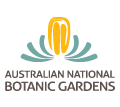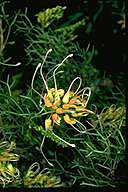 |
In Flower This WeekA weekly news-sheet prepared by a Gardens volunteer.Numbers in brackets [ ] refer to garden bed 'Sections'. Plants in flower are in bold type. |
10 May 2002
 |
In Flower This WeekA weekly news-sheet prepared by a Gardens volunteer.Numbers in brackets [ ] refer to garden bed 'Sections'. Plants in flower are in bold type. |
Flowers, including Scaevola ‘New Blue’ [Section 174], along Banks Walk are so bright. However many less obvious flowers are also worth viewing, such as the nearby Scaevola brookeana [Section 174], with interesting stem-clasping leaves and small mauve fan flowers on a dwarf upright plant, and Eremophila strongylophylla [Section 174], in the crescent-shaped bed, a prostrate plant with blue bugle-shaped flowers.
Because the glorious sunny autumn days continue, this walk will venture higher up the Gardens where colourful flowers continue. Taking the road on the far side of the Rainforest Gully, Banksia ‘Giant Candles’ [Section 107] stands tall with a mature elongated gold flower spike on top overlooking many immature dull gold flower spikes below. On the other side of the Brittle Gum Lawn, Banksia spinulosa var. spinulosa [Section 110] is a denser rounded shrub with shorter flower spikes, coloured a dazzling gold and ribbed with maroon styles. In the triangular bed, Alyogyne ‘West Coast Gem’ [Section 17] stands in the centre displaying its attractive purple hibiscus-like flowers. Geraldton Wax cultivar Chamelaucium ‘Cascade Brook’ [Section 17] is picturesquely laden with mottled pink open flowers while, opposite, a group of Crowea ‘Festival’ [Section 123], all of similar size, is clad with bright pink star flowers. Sheltering between the fronds of large tree ferns, Dicksonia antarctica [Section 140], a tea-tree, Leptospermum amboinense [Section 140], has open white flowers with pink centres along the low lateral stems.
Following this path, banksias include Banksia oblongifolia [Section 37], a low spreading shrub with soft green flower spikes. Banksia ericifolia [Section 37], about 30 years old, grand with longer, bright orange flower spikes, while Banksia media [Section 37] has denser mustard coloured flower spikes of greater circumference. There too, is a waratah, Telopea mongaensis [Section 37], with a few out-of-season open red flowers.
 On
the other side of the covered shelter, Banksia plagiocarpa [Section
37] is a tall open shrub with, among the aged flower spikes, fresh mature flower
spikes, dark with a tint of mauve. Behind is Grevillea dielsiana
[Section 37], an erect shrub with prickly divided foliage and bright with pendent
clusters of red-orange flowers. Banksias, in particular, are being frequented
by such birds as the New Holland Honeyeater, the Eastern Spinebill and larger
birds including the colourful Crimson Rosella and the Red Wattlebird, all enjoying
the nectar of the flowers.
On
the other side of the covered shelter, Banksia plagiocarpa [Section
37] is a tall open shrub with, among the aged flower spikes, fresh mature flower
spikes, dark with a tint of mauve. Behind is Grevillea dielsiana
[Section 37], an erect shrub with prickly divided foliage and bright with pendent
clusters of red-orange flowers. Banksias, in particular, are being frequented
by such birds as the New Holland Honeyeater, the Eastern Spinebill and larger
birds including the colourful Crimson Rosella and the Red Wattlebird, all enjoying
the nectar of the flowers.
From the upper path, Grevillea victoriae [Section 37] is a large shrub decorated with pendent rust-coloured flower clusters while down below, Grevillea triloba [Section 37] is showered with fine white flowers over this spreading shrub. Up amongst the she-oaks, Allocasuarina portuensis [Section 40] is a tree of medium size, with long fine needle-like foliage and small red female flowers along its long lateral branches. Forest Oak, Allocasuarina torulosa [Section 40], another tree of medium size, has rough, corky bark and arching branches well covered with fading rust-coloured male flowers…still a handsome tree.
Relaxing walk … many colourful plants. Barbara Daly.
| Return to: | Australian National Botanic Gardens | Previous
'In Flower' Weeks |